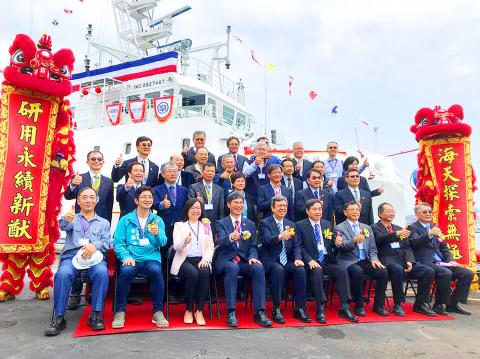Vice President Chen Chien-jen (陳建仁) yesterday inaugurated two new research vessels at CSBC Corp, Taiwan’s (CSBC, 台灣國際造船) Keelung Yard, saying that oceanography in the nation is entering a new era, with the government devoting more resources to the field.
Commissioned by the Ministry of Science and Technology, CSBC in January last year began building the R/V New Ocean Researcher 2 and R/V New Ocean Researcher 3 at a budget of NT$470 million (US$15.4 million) each.
The two 811-tonne vessels are to replace R/V Ocean Researcher II and R/V Ocean Researcher III, managed by National Taiwan Ocean University (NTOU) and National Sun Yat-sen University (NSYSU) respectively.

Photo: CNA
Oceanography in the nation is entering a new era with the inauguration of the new vessels, while the legislature earlier this month also passed the Ocean Basic Act (海洋基本法), aiming to bring people closer to the marine environment, Chen said.
Ocean research in Taiwan can be traced back about half a century when the nation took over a decommissioned US naval ship and renamed it the Chiu Lien (九連號), NSYSU vice president Chen Yang-yih (陳陽益) said, adding that Taiwan became increasingly competent over the years and developed its own facilities.
The new vessels were planned more than a decade ago, as the old ones have been in operation for more than 25 years and existing facilities are unable to satisfy research requirements, NTOU president Chang Ching-fong (張清風) said.
Taiwan should make better use of its edge in marine exploration and cultivate related talent, Chang said, expressing the hope that the government will devote more resources to supporting domestic oceanography.
The two new vessels are equipped with imported state-of-the-art instruments, including a multibeam echo sounder that can produce high-resolution images to map the sea floor; an acoustic Doppler current profiler that can measure current velocity; and a dynamic positioning system that can more precisely maintain a vessel’s position during a sampling mission at sea.
A third new research vessel — the 2,155-tonne R/V New Ocean Researcher 1 — is expected to be completed before the end of this year, Minister of Science and Technology Chen Liang-gee (陳良基) said.
Along with the 2,629-tonne R/V Legend (勵進) — which was launched last year and is operated by the National Applied Research Laboratories’ Taiwan Ocean Research Institute — the research vessels would allow oceanographers to plan more diverse expeditions further afield, he said.
Scientists are encouraged to engage in offshore wind farm engineering and underwater archeology, in addition to the existing disciplines of physical and chemical oceanography, as well as marine biology and geology, he added.

The US government has signed defense cooperation agreements with Japan and the Philippines to boost the deterrence capabilities of countries in the first island chain, a report by the National Security Bureau (NSB) showed. The main countries on the first island chain include the two nations and Taiwan. The bureau is to present the report at a meeting of the legislature’s Foreign Affairs and National Defense Committee tomorrow. The US military has deployed Typhon missile systems to Japan’s Yamaguchi Prefecture and Zambales province in the Philippines during their joint military exercises. It has also installed NMESIS anti-ship systems in Japan’s Okinawa

‘WIN-WIN’: The Philippines, and central and eastern European countries are important potential drone cooperation partners, Minister of Foreign Affairs Lin Chia-lung said Minister of Foreign Affairs Lin Chia-lung (林佳龍) in an interview published yesterday confirmed that there are joint ventures between Taiwan and Poland in the drone industry. Lin made the remark in an exclusive interview with the Chinese-language Liberty Times (the Taipei Times’ sister paper). The government-backed Taiwan Excellence Drone International Business Opportunities Alliance and the Polish Chamber of Unmanned Systems on Wednesday last week signed a memorandum of understanding in Poland to develop a “non-China” supply chain for drones and work together on key technologies. Asked if Taiwan prioritized Poland among central and eastern European countries in drone collaboration, Lin

NO CONFIDENCE MOTION? The premier said that being toppled by the legislature for defending the Constitution would be a democratic badge of honor for him Premier Cho Jung-tai (卓榮泰) yesterday announced that the Cabinet would not countersign the amendments to the local revenue-sharing law passed by the Legislative Yuan last month. Cho said the decision not to countersign the amendments to the Act Governing the Allocation of Government Revenues and Expenditures (財政收支劃分法) was made in accordance with the Constitution. “The decision aims to safeguard our Constitution,” he said. The Constitution stipulates the president shall, in accordance with law, promulgate laws and issue mandates with the countersignature of the head of the Executive Yuan, or with the countersignatures of both the head of the Executive Yuan and ministers or

CABINET APPROVAL: People seeking assisted reproduction must be assessed to determine whether they would be adequate parents, the planned changes say Proposed amendments to the Assisted Reproduction Act (人工生殖法) advanced yesterday by the Executive Yuan would grant married lesbian couples and single women access to legal assisted reproductive services. The proposed revisions are “based on the fundamental principle of respecting women’s reproductive autonomy,” Cabinet spokesperson Michelle Lee (李慧芝) quoted Vice Premier Cheng Li-chiun (鄭麗君), who presided over a Cabinet meeting earlier yesterday, as saying at the briefing. The draft amendment would be submitted to the legislature for review. The Ministry of Health and Welfare, which proposed the amendments, said that experts on children’s rights, gender equality, law and medicine attended cross-disciplinary meetings, adding that